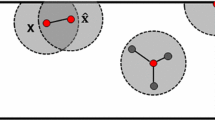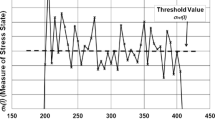The application of the linear micropolar theory to the strength analysis of bioceramic materials for bone reconstruction is described. Micropolar elasticity allows better results to be obtained for microstructural and singular domains as compared to the classical theory of elasticity. The fundamental equations of the Cosserat continuum are cited. The description of FEM implementation of micropolar elasticity is given. The results of solving selected 3D test problems are presented. Comparison of classical and micropolar solutions is discussed.







Similar content being viewed by others
References
S. Cowin (Ed.), Bone Mechanics Handbook, CRC Press, Boca Raton, FL (2001).
Y. H. An and R. A. Draughn (Eds.), Mechanical Testing of Bone and the Bone–Implant Interface, CRC Press, Boca Raton, FL (2000).
S. C. Cowin and D. H. Hegedus, “Bone remodeling I: theory of adaptive elasticity,” J. Elasticity, 6, No. 3, 313–326 (1976).
D. H. Hegedus and S. C. Cowin, “Bone remodeling II: small strain adaptive elasticity,” J. Elasticity, 6, No. 4, 337–352 (1976).
T. Lekszycki and F. dell’Isola, “A mixture model with evolving mass densities for describing synthesis and resorption phenomena in bones reconstructed with bio-resorbable materials,” Z. Angew. Math. Mech, 92, No. 6, 426–444 (2012).
I. Giorgio, U. Andreaus, D. Scerrato, and F. dell’Isola, “A visco-poroelastic model of functional adaptation in bones reconstructed with bio-resorbable materials,” Biomech. Model. Mechanobiol., 15, No. 5, 1325–1343 (2016).
I. Giorgio, U. Andreaus, D. Scerrato, and P. Braidotti, “Modeling of a non-local stimulus for bone remodeling process under cyclic load: Application to a dental implant using a bioresorbable porous material,” Math. Mech. Solids (2016), DOI: 10.1177/1081286516644867.
I. Giorgio, U. Andreaus, T. Lekszycki, and A. Della Corte, “The influence of different geometries of matrix/scaffold on the remodeling process of a bone and bio-resorbable material mixture with voids,” Math. Mech. Solids (2015), DOI: 10.1177/1081286515616052.
M. Vallet-Regi, I. Izquierdo-Barba, and M. Colilla, “Structure and functionalization of mesoporous bioceramics for bone tissue regeneration and local drug delivery,” Phil. Trans. R. Soc. A, 370, 1400–1421 (2012).
V. Karageorgiou and D. Kaplan, “Porosity of 3D biomaterial scaffolds and osteogenesis,” Biomaterials, 26, 5474–5491 (2005).
A. C. Eringen, Microcontinuum Field Theories: I. Foundations and Solids, Springer-Verlag, New York (1999).
V. A. Eremeyev, L. P. Lebedev, and H. Altenbach, Foundations of Micropolar Mechanics, Springer, Berlin (2013).
J. F. C. Yang and R. S. Lakes, “Experimental study of micropolar and couple stress elasticity in compact bone in bending,” J. Biomech., 15, No. 2, 91–98 (1982).
H. C. Park and R. S. Lakes, “Cosserat micromechanics of human bone: strain redistribution by a hydration sensitive constituent,” J. Biomech., 19, No. 5, 385–397 (1986).
R. S. Lakes, “Experimental microelasticity of two porous solids,” Int. J. Solids Struct., 22, No. 1, 55–63 (1986).
R. S. Lakes, “Experimental micro mechanics methods for conventional and negative Poisson’s ratio cellular solids as Cosserat continua,” J. Eng. Mater. Technol., 113, No. 1, 148–155 (1991).
I. Goda, M. Assidi, S. Belouettar, and J. F. Ganghoffer, “A micropolar anisotropic constitutive model of cancellous bone from discrete homogenization,” J. Mech. Behav. Biomed. Mater., 16, 87–108 (2012).
I. Goda, M. Assidi, and J. F. Ganghoffer, “A 3D elastic micropolar model of vertebral trabecular bone from lattice homogenization of the bone microstructure,” Biomech. Model. Mechan., 13, No. 1, 53–83 (2014).
I. Goda and J. F. Ganghoffer, “Identification of couple-stress moduli of vertebral trabecular bone based on the 3D internal architectures,” J. Mech. Behav. Biomed. Mater., 51, 99–118 (2015).
F. dell’Isola, D. Steigmann, and A. Della Corte, “Synthesis of fibrous complex structures: designing microstructure to deliver targeted macroscale response,” Appl. Mech. Rev., 67, No. 6, 060804-060804-21 (2016).
F. dell’Isola, I. Giorgio, M. Pawlikowski, and N. L. Rizzi, “Large deformations of planar extensible beams and pantographic lattices: heuristic homogenization, experimental and numerical examples of equilibrium,” Proc. Roy. Soc. A, 472, Issue 2185 (2016), DOI: 10.1098/rspa.2015.0790.
D. Scerrato, I. Giorgio, N. L. Rizzi, “Three-dimensional instabilities of pantographic sheets with parabolic lattices: numerical investigations,” Z. Angew. Math. Phys., 67, No. 3, 1–19 (2016).
D. Scerrato, I. A. Zhurba Eremeeva, T. Lekszycki, and N. L. Rizzi, “On the effect of shear stiffness on the plane deformation of linear second gradient pantographic sheets,” Z. Angew. Math. Mech. (2016), DOI: 10.1002/zamm.201600066.
V. A. Eremeyev and W. Pietraszkiewicz, “Material symmetry group of the non-linear polar-elastic continuum,” Int. J. Solids Struct., 49, No. 14, 1993–2005 (2012).
V. A. Eremeyev and W. Pietraszkiewicz, “Material symmetry group and constitutive equations of micropolar anisotropic elastic solids,” Math. Mech. Solids, 21, No. 2, 210–221 (2016).
T. C. Kennedy and J. B. Kim, “Dynamic stress concentrations in micropolar elastic materials,” Comput. Struct., 45, No. 1, 53–60 (1992).
P. Kaloni and T. Ariman, “Stress concentration effects in micropolar elasticity,” Z. Angew. Math. Phys., 18, No. 1, 136–141 (1967).
A. R. Khoei, S. Yadegari, and S. O. R. Biabanaki, “3D finite element modeling of shear band localization via the micro-polar Cosserat continuum theory,” Comp. Mater. Sci., 49, No. 4, 720–733 (2010).
Acknowledgments
The research received funding from the People Program (Marie Curie ITN transfer) of the European Union’s Seventh Framework Programme for research, technological development and demonstration under grant agreement No. PITN-GA-2013- 606878.
Author information
Authors and Affiliations
Additional information
Translated from Problemy Prochnosti, No. 4, pp. 119 – 128, July – August, 2016.
Rights and permissions
About this article
Cite this article
Eremeyev, V.A., Skrzat, A. & Vinakurava, A. Application of the Micropolar Theory to the Strength Analysis of Bioceramic Materials for Bone Reconstruction. Strength Mater 48, 573–582 (2016). https://doi.org/10.1007/s11223-016-9800-1
Received:
Published:
Issue Date:
DOI: https://doi.org/10.1007/s11223-016-9800-1




